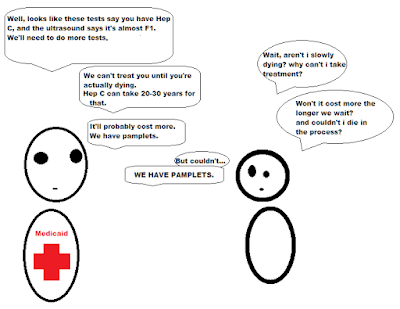There was Incivek (telaprevir) the $83,509 Drug
When it came out it was heralded as a wonder drug, because it nearly doubled the (SVR)cure rate of HCV meds at the time.
It cured my mother, but while she was on it she had multiple transfusions and her anemia was controlled by ProCrit (a red-blood cell boosting drug). It was later found out to have been a direct contributor to several deaths, and thousands who took it were left with permanent skin damage regardless of success of treatment or not.
When the drug was pulled from the market, there was a feeling in the HCV community. When a cure with rates that good is pulled, even if it carries a black-box(may cause death) label from the FDA, some would risk it.
I nearly died while on it due to my anemia and bursting esophageal varices. From that point on, like many F4 patients I was barred from using Interferon for new treatments.
The term warehousing became popularized with HCV patients. In 2013 Sovaldi and Viekira Pak were undergoing trials and it was believed by many that there would be a host of new drugs being released within a few years (referring to 2014/2015)
The existing treatments' side effects were troublesome, and the results were poor in late 2012 after Incivek became taboo. Patients who could have taken those treatments opted not to because when your options are to feel terrible for 48 weeks and 50% chance, or wait a year or two for a 12-24 week treatment with a 90%+ chance...it's not hard to see the appeal. Especially when you consider that majority of the deferring patients would have been in the F0-F2 category, which has minimal symptoms.
Now, back to 2015. Sovaldi, Harvoni, Viekira Pak and other partner medications like Olysio and Daclatasvir have been released. Every Pharmaceutical is throwing in their hat. Merck is even entering the all oral ring early next year with a grazoprevir elbasvir combo similar to Harvoni. Drug makers are ensuring that each of the drugs targets specific genotypes, and it's not purely scientific. In doing so it allows them to rush the FDA approval process for what's called "Breakthrough therapy" designation. The result is a whole lot of new HCV drugs that treat lots of genotypes of HCV.
Which means that all of those HCV patients can get treatment, right?
Not quite. Because at it would turn out these companies are using Incivek's pricing model.
Let's talk business for a second what makes that price point? The price won't always be as high as it is now. In a few years the drugs will lose their patent's exclusivity
Usually this means that the drug needs to profit as much as it can within the first five years before generics can start being licensed. Patents still protect a drug from copycats for 20 years from date of filing. So they'll still make large profits until the patent expires.
The Research and Development (RnD), litigation from patent trolling, and acquisitions are also costs to bear in mind. Acquisitions can cost hundreds of millions to billions of dollars. Most Manufacturers acquire smaller labs who are/were producing HCV meds. After that, it's direct injections of capital for RnD expansion until its market ready. Then the lab gets to use the distribution methods, sales channels and brand recognition of a major name. Make no mistake, they're making billions off these deals, but they're also billion dollar risks.
With lots of high priced drugs on the market, both AbbVie (Viekira Pak maker) and Gilead(Sovaldi/Harvoni maker) offered direct to discounts to consumers. AbbVie started to patent troll Gilead in attempt to slow down the impending juggernaut Harvoni. Insurers and Medicaid/Medicare had to figure out a way to handle the tidal wave of some of the largest groups of HCV patients warehoused. The restrictions are now at such a point where those patients still warehoused now find the door locked by health insurance restrictions.
This is the Locked Warehouse Door.
The reality of new HCV patients is one of the locked warehouse door. For those who await treatment, either existing or pending treatments, they must wait for the bureaucracy of the key. Hopefully by then the price of that key becomes affordable.
In an effort to help categorize the different Tweets regarding HCV, consider using the hashtag: #LockedWarehouseDoor when tweeting about health insurance or Medicaid restrictions and high-cost HCV Meds. Help remind pharmaceutical companies, insurance companies and lawmakers that the "warehouse" of HCV patients are dying to get out.
if you were denied Sovaldi, Harvoni, Viekira Pak, or any other new HCV med, if you had to go through lots of hurdles for treatment; I urge you to tweet about them with the hashtag: #LockedWarehouseDoor.






